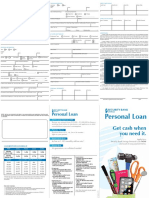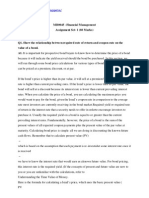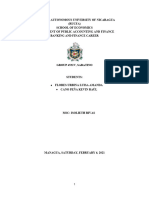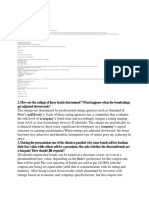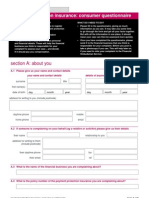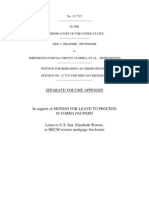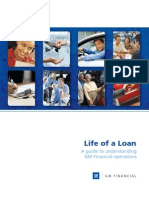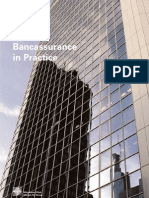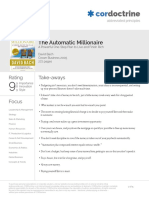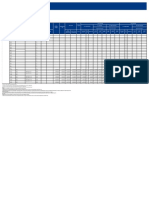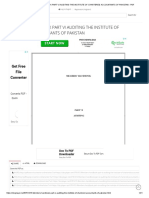Microsoft Word - Week 6 Bonds Version - 1 Solution 9th 04 2019
Microsoft Word - Week 6 Bonds Version - 1 Solution 9th 04 2019
Uploaded by
Mark LiCopyright:
Available Formats
Microsoft Word - Week 6 Bonds Version - 1 Solution 9th 04 2019
Microsoft Word - Week 6 Bonds Version - 1 Solution 9th 04 2019
Uploaded by
Mark LiOriginal Description:
Original Title
Copyright
Available Formats
Share this document
Did you find this document useful?
Is this content inappropriate?
Copyright:
Available Formats
Microsoft Word - Week 6 Bonds Version - 1 Solution 9th 04 2019
Microsoft Word - Week 6 Bonds Version - 1 Solution 9th 04 2019
Uploaded by
Mark LiCopyright:
Available Formats
ACCT1060 Management Accounting and Business
7.5% Graded Group Assessment Week - 6
Student 1 Student 2 Student 3 Student 4
ID Number
Tutor’s Name
Day + Time of
your tutorial
class
Your name
ALLOWABLE MATERIALS AND INSTRUCTIONS TO GROUPS
1. This is a limited open book assessment. Please refer to the instruction below.
(Students can use their lecture notes and only laptop can be used to get access to given company
data)
2. Spend 45 minutes + 5 minutes reading time
3. Please form four-member group to do the assessment (expects equal contribution from
each member of a group)
4. Non-programmable calculators are permitted.
Programmable calculators are not permitted at any time.
5. Except your laptop, all electronic devices, mobile phones and smart gadgets must be
switched off and placed INSIDE your bag. You are in breach of exam conditions if it is on
your person (i.e pocket).
6. Attempt ALL questions and ALL parts of questions
7. NOTE: Assessment cannot be retained by the student and must not be removed from
the assessment venue.
ACCT1060 MAB Week-6 In-class Assessment Version -1 1
QUESTION ONE – BONDS CHARACTERISTICS
a. Discuss as for why companies decide to issue bonds as a source of finance?
There will be very different answers from the students for this question, therefore, I
will allow you to use your judgment on students’ answers. However, see the
suggested guideline below:
Corporations issue bonds for several reasons:
1. Provides corporations with a way to raise capital without diluting the current
shareholders' equity.
2. With bonds, corporations can often borrow at a lower interest rate than the
rate available in banks. By issuing bonds directly to the investors,
corporations can eliminate the banks as "middlemen" in the transactions.
Without the intermediaries, the borrowing process becomes more efficient
and less expensive.
3. By issuing bonds, corporations can often borrow money for a fixed rate for a
longer term than it could at a bank. Most banks will not make fixed rate
loans for longer than five years because they fear losing money if their cost
of funds (raised by selling CDs, savings accounts, and the like) rises to a
higher rate than long-term loans. Most companies want to borrow money for
long terms and so elect to issue bonds.
4. The bond market offers a very efficient way to borrow capital. By issuing
bonds, the borrower is spared the task of undergoing numerous separate
negotiations and transactions in order to raise the capital it needs.
Instead, when corporation issues bond, creates one master loan agreement and
offers investors a chance to participate in the loan. The company offers the
identical deal to all investors regardless of whether the individuals interested in
buying just one bond each or corporations buying 1000 bonds. The master loan
agreement between the corporation and the investors is called a bond indenture.
The indenture contains information that you would expect in any loan agreement
such as:
• The amount of money the company is borrowing.
• The interest rate the company will pay.
• The collateral for the loan (if any).
• When the company will make its interest payments.
• Whether the company will pay off the loan, that is, when the bonds will
mature.
• Whether the company and/or the investors will have the choice of
shortening the bond's original maturity.
ACCT1060 MAB Week-6 In-class Assessment Version -1 2
b. Explain why bond prices have an inverse relationship with interest rate movements?
Suggested Answer:
Since the coupon rate of a bond is fixed until maturity, the price of a bond will vary according
to interest rate movements in the market. If the coupon rate is the same as the market interest
rate, then the bond will sell for its par value (i.e. a ‘par bond’).
However, if the coupon rate is greater than the market interest rate, then there will be increased
demand for the bond which causes an increase in the market price of the bond, resulting in the
bond selling for a premium (i.e. a ‘premium bond’).
Conversely, if the coupon rate is less than the market interest rate, then there will be decreased
demand for the bond which causes a decrease in the market price of the bond, resulting in the
bond selling for a discount (i.e. a ‘discount bond’).
In this way, bond prices are said to have an inverse relationship with interest rate movements,
with bonds prices increasing when market interest rates decline and bond prices decreasing
when market interest rates rise.
QUESTION TWO – BONDS VALUATION
Sonia bought a bond when it was issued by ABC Ltd 14 years ago. The bond which has a $
1000 face value and a coupon rate equal to 10 per cent. Matures in 6 years. Interest is paid
every six months; the next interest payment is scheduled for six months from today. If the yield
on similar risk investments is 14 per cent, what is the current market value of the bond?
ACCT1060 MAB Week-6 In-class Assessment Version -1 3
QUESTION THREE - BONDS VALUATION (Woolworths Group Ltd)
Key data regarding Woolworths’ Bond valuation have been provided below:
The required return on the Wool's Bond (rd) 4%
Number of years (periods) to maturity (n) 5
Par value (face value) in dollars (M) $1,000
Coupon rate 6%
a. Calculate the Bond’s value, if interest is paid annually and justify your answer.
B0 = I * (PVIFA rd, n) + M * (PVIF rd, n)
Ø M=$1,000
Ø Cr = 6%
Ø rd = 4%
Ø n=5
Ø I = coupon interest rate X per value : 0.06 X $1,000 = $60
Ø PVIFA 4%, 5 = 4.452
Ø PVIF 4%, 5 = 0.822
B0 = $60 * 4.452 + $1,000 * 0.822 = $1,089.12
Therefore, the bond has a value of approximately $1,089 and is selling at a premium of
$89 (1,089-1,000), because of r < C
b. Repeat the calculations in question (b) assuming that interest is paid semi-annually
and justify your obtained results.
!
B0 = * (PVIFA rd/2, 2n) + M * (PVIF rd/2, 2n)
"
Ø M=$1,000
As interest rate (C) is paid semi-annual:
Ø Cr/2 = (6/2) % = 3%
Ø rd/2 = (4/2) % = 2%
Ø 2n = 5 X 2 = 10
ACCT1060 MAB Week-6 In-class Assessment Version -1 4
!
Ø "
= I/2 * per value : 0.03 X $1,000 = $30
Ø PVIFA 2%, 10 = 8.983
Ø PVIF 2%, 10 = 0.820
B0 = $30 * 8.983 + $1,000 * 0.820 = $1,089.49
Therefore, the bond has a value of approximately $1,089 and would sell for a premium
of about $89 (1,089-1,000), because the required return is less than the coupon interest
rate.
c. Compare and discuss differences between the bond values for each required return
calculated in question (b) and (c) under annual versus semi-annual payment
assumptions.
Comparing above results in question c ($1,089.49) with the $1,089.12 value found
earlier for annual compounding (see question c), we can see that the bond’s value is
(slightly) higher when semi-annual interest is paid. This will always occur when the
bond sells at a premium. For bonds selling at a discount, the opposite will occur: the
value with semi-annual interest will be less than with annual interest.
d. What factors determine a bond’s rating? Why is the rating important to the
Woolworth’s CFO?
Ratings involve a judgment about the future risk potential of the bond. Although they
deal with expectations, several historical factors seem to play a significant role in their
determination. Bond ratings are favourably affected by (1) a greater reliance on equity,
and not debt, in financing the firm, (2) profitable operations, (3) a low variability in
past earnings, (4) large firm size, and (5) little use of subordinated debt. In turn, the
rating a bond receives affects the rate of return demanded on the bond by the investors.
The poorer the bond rating, the higher the rate of return demanded in the capital
markets.
For the financial manager, bond ratings are extremely important. They provide an
indicator of default risk that in turn affects the rate of return that must be paid on
borrowed funds.
ACCT1060 MAB Week-6 In-class Assessment Version -1 5
1. Bond ratings
Assume that Woolworths recently acquired an alcohol beverage company that was in financial
distress. Because of the acquisition, Mood’s downgraded this Bond from Baa2 to Ba2 to
reflect an increase in risks of the Woolworths Group Ltd. What impact will this have on the
bond value? Explain. NOTE THAT CALCULATIONS ARE NOTE REQUIRED HERE.
Financial managers usually are concerned with ratings of the bond issue, because these ratings
affect saleability and cost. There exist an inverse relationship between the quality of a bond
and the rate of return that must be provided to bondholders. This reflects the lender’s risk-
return trade-off.
Therefore, the lower a bond’s rating, the higher the perceived default risk, the higher the interest
rate required by investors, which lead potentially to a reduction in Woolworths’ bond value.
Formulas:
1. Basic bond valuation for annual interest rate
Bo = I * (PVIFA rd, n) + M * (PVIF rd, n)
ü Where Bo = value of the bond value = (Vd)
ü M = Maturity Value (par value)
ü C = coupon interest rate
ü I represent an interest paid in dollars (coupon payment in dollars):
ü I = coupon interest rate (C ) * per value (M);
ü PVIFA = present value interest factors for one-dollar annuity discounted at r for n
periods. Corresponding values are obtained from the financial table.
ü rd = the average rate of return investors requires to invest in the bond.
ü n = number of years (periods)
ü PVIF = present value interest factors for one dollar discounted at r for n periods.
2. Bond valuation for interest paid semi-annual
!
Bo = "* (PVIFA rd/2, 2n) + M * (PVIF rd/2, 2n)
ACCT1060 MAB Week-6 In-class Assessment Version -1 6
You might also like
- Meet Your Strawman and Whatever You Want To Know EditabilDocument83 pagesMeet Your Strawman and Whatever You Want To Know Editabilyakee796% (138)
- Block L - Salary-Based Budgeting Worksheet 8 - Sheet1Document2 pagesBlock L - Salary-Based Budgeting Worksheet 8 - Sheet1api-49586045967% (3)
- WorldcomDocument5 pagesWorldcomHAN NGUYEN KIM100% (2)
- East Coast Yacht's Expansion Plans-06!02!2008 v2Document3 pagesEast Coast Yacht's Expansion Plans-06!02!2008 v2percyNo ratings yet
- Introduction To Corporate Finance 4th Edition Booth Test Bank DownloadDocument36 pagesIntroduction To Corporate Finance 4th Edition Booth Test Bank DownloadJudy Snell100% (21)
- 08 Corporate BondsDocument4 pages08 Corporate Bondspriandhita asmoro75% (4)
- Mid Term FNCE 2020Document13 pagesMid Term FNCE 2020MOHAMED JALEEL MOHAMED SIDDEEKNo ratings yet
- Tut Lec 5 - Chap 80Document6 pagesTut Lec 5 - Chap 80Bella SeahNo ratings yet
- Security Bank Personal Loan App FormDocument2 pagesSecurity Bank Personal Loan App FormDemp Almiranez75% (4)
- The Birth Certificate Bond ExplainedDocument8 pagesThe Birth Certificate Bond ExplainedTaz442 Tz100% (8)
- Bond FundamentalsDocument19 pagesBond FundamentalsInstiRevenNo ratings yet
- Chapter 5: Bond: BY: PN Azlida Binti AbdullahDocument44 pagesChapter 5: Bond: BY: PN Azlida Binti Abdullahazlida abdullahNo ratings yet
- Lecture Notes For FSA (Credit Analysis)Document43 pagesLecture Notes For FSA (Credit Analysis)durga03100% (1)
- Bonds Valuation 2017 STUDocument4 pagesBonds Valuation 2017 STUAnissa GeddesNo ratings yet
- BONDrevised For En9Document16 pagesBONDrevised For En9leylaNo ratings yet
- Ch2 Testbank Part 2 (2) .AnswerdDocument8 pagesCh2 Testbank Part 2 (2) .Answerdtarek ahmedNo ratings yet
- Bonds: Here Are Some Benefits They Can ProvideDocument7 pagesBonds: Here Are Some Benefits They Can ProvidefaqehaNo ratings yet
- Chapter 7a - Bonds ValuationDocument22 pagesChapter 7a - Bonds ValuationAian Cortez100% (1)
- Tutorial 3: Bonds/Fixed Income SecuritiesDocument14 pagesTutorial 3: Bonds/Fixed Income Securities1 KohNo ratings yet
- Chapter 4 - MinicaseDocument4 pagesChapter 4 - MinicaseMuhammad Aditya TMNo ratings yet
- Full Download of Financial Markets and Institutions 8th Edition Mishkin Solutions Manual in PDF DOCX FormatDocument41 pagesFull Download of Financial Markets and Institutions 8th Edition Mishkin Solutions Manual in PDF DOCX Formatschouerreca100% (2)
- Chapter 7. Bonds and Their Valuation: A B C D E F G H I 1 2 3 4Document13 pagesChapter 7. Bonds and Their Valuation: A B C D E F G H I 1 2 3 4Naufal IhsanNo ratings yet
- Final FinDocument28 pagesFinal Finashraful islam shawonNo ratings yet
- Financial Markets and Institutions 8th Edition Mishkin Solutions Manual 2024 scribd download full chaptersDocument41 pagesFinancial Markets and Institutions 8th Edition Mishkin Solutions Manual 2024 scribd download full chapterszaylanmawati42100% (4)
- SampleQuestions Finance 1Document9 pagesSampleQuestions Finance 1YiğitÖmerAltıntaşNo ratings yet
- Chapter 6 Bond - Assignment AnswerDocument6 pagesChapter 6 Bond - Assignment AnswerRoger RogerNo ratings yet
- Instant Download for Financial Markets and Institutions 8th Edition Mishkin Solutions Manual 2024 Full Chapters in PDFDocument41 pagesInstant Download for Financial Markets and Institutions 8th Edition Mishkin Solutions Manual 2024 Full Chapters in PDFahatovrinetaNo ratings yet
- Fa-I Chapter FiveDocument33 pagesFa-I Chapter FiveHussen AbdulkadirNo ratings yet
- Tutorial 4Document3 pagesTutorial 4brahim.safa2018No ratings yet
- Tutorial 4Document3 pagesTutorial 4casatn099No ratings yet
- Topic 2 - Bond Valuation-A132Document58 pagesTopic 2 - Bond Valuation-A132Baby KhorNo ratings yet
- DANIYA - Chapter 5 Mini Case Individual - SOLVEDDocument5 pagesDANIYA - Chapter 5 Mini Case Individual - SOLVEDdani987yaNo ratings yet
- Chapter Four FMDocument7 pagesChapter Four FMHope GoNo ratings yet
- Accounting For Liabilities: Learning ObjectivesDocument39 pagesAccounting For Liabilities: Learning ObjectivesJune KooNo ratings yet
- Solución Mini Caso Cap. 8Document5 pagesSolución Mini Caso Cap. 8Anonymous 5qHvuEIVz0No ratings yet
- 7 8 Equivalence Rev 1Document32 pages7 8 Equivalence Rev 1Mateo, Elijah Jonathan C.No ratings yet
- FA - Longterm LiabilitiesDocument39 pagesFA - Longterm LiabilitiesHuzaiFa JavedNo ratings yet
- fmim.16.Ch3B_ChapterDocument7 pagesfmim.16.Ch3B_ChaptervasuuumNo ratings yet
- Valuation of BondsDocument4 pagesValuation of BondsArnie Jhane PantaleonNo ratings yet
- AFCP810 Finance PrinciplesDocument3 pagesAFCP810 Finance PrinciplesbustitoutNo ratings yet
- Abdul Qadir Khan (Fixed Income Assignement No.5)Document10 pagesAbdul Qadir Khan (Fixed Income Assignement No.5)muhammadvaqasNo ratings yet
- QuestionsDocument6 pagesQuestionsNhư Phạm Thị QuỳnhNo ratings yet
- Lecture 3 - Valuation - Bonds, Equity and ProjectsDocument28 pagesLecture 3 - Valuation - Bonds, Equity and ProjectshassankayaneNo ratings yet
- Chapter 10 Solutions Excluding HomeworkDocument31 pagesChapter 10 Solutions Excluding HomeworkMissing PersonNo ratings yet
- Strategic Capital Group Workshop #4: Bond ValuationDocument29 pagesStrategic Capital Group Workshop #4: Bond ValuationUniversity Securities Investment TeamNo ratings yet
- Bond and Stock Valuation Homework Mini CaseDocument8 pagesBond and Stock Valuation Homework Mini Caseercjdfay100% (1)
- Group 5 - Bond and Stock ValuationDocument56 pagesGroup 5 - Bond and Stock Valuationtuan sonNo ratings yet
- Valuation of Securities: by - ) Ajay Rana, Sonam Gupta, Shivani, Gurpreet, ShilpaDocument46 pagesValuation of Securities: by - ) Ajay Rana, Sonam Gupta, Shivani, Gurpreet, ShilpaTanmoy ChakrabortyNo ratings yet
- Bond Valuations:: What Does "Bond Valuation" Mean?Document7 pagesBond Valuations:: What Does "Bond Valuation" Mean?SandeepNo ratings yet
- Reporting and Interpreting Bonds: Answers To QuestionsDocument43 pagesReporting and Interpreting Bonds: Answers To QuestionsceojiNo ratings yet
- MB0045 - Financial Management Assignment Set-1 (60 Marks)Document8 pagesMB0045 - Financial Management Assignment Set-1 (60 Marks)Ahmed BarkaatiNo ratings yet
- Work FinanceDocument13 pagesWork FinanceScribdTranslationsNo ratings yet
- Chapter 14: Financing Liabilities: Bonds and Long-Term Notes PayableDocument4 pagesChapter 14: Financing Liabilities: Bonds and Long-Term Notes PayableJason BrightNo ratings yet
- Homework Notes Unit 3 MBA 615Document9 pagesHomework Notes Unit 3 MBA 615Kevin NyasogoNo ratings yet
- Bond ValuationDocument46 pagesBond ValuationNor Shakirah ShariffuddinNo ratings yet
- Week 2Document11 pagesWeek 2AILIN SONGNo ratings yet
- Session 45 - Valuation of Bonds - FMT2019 PDFDocument36 pagesSession 45 - Valuation of Bonds - FMT2019 PDFmiriel JonNo ratings yet
- Chapter 06 GitmanDocument38 pagesChapter 06 GitmanLBL_LowkeeNo ratings yet
- Features of Fixed Income SecuritiesDocument9 pagesFeatures of Fixed Income Securitiesalmirb70% (1)
- Which of The Following Terms Apply To A Bond? Face Value Principal CouponDocument15 pagesWhich of The Following Terms Apply To A Bond? Face Value Principal CouponmpkNo ratings yet
- Transcript of Bond Analysis and ValuationDocument5 pagesTranscript of Bond Analysis and Valuationanika fierroNo ratings yet
- Valuation of Bonds PDFDocument17 pagesValuation of Bonds PDFMoud KhalfaniNo ratings yet
- Fixed Income Securities: A Beginner's Guide to Understand, Invest and Evaluate Fixed Income Securities: Investment series, #2From EverandFixed Income Securities: A Beginner's Guide to Understand, Invest and Evaluate Fixed Income Securities: Investment series, #2No ratings yet
- DI Questions For IBPS Exam 2017Document534 pagesDI Questions For IBPS Exam 2017Abhishek KrNo ratings yet
- Payment Protection Insurance: Consumer Questionnaire: Section A: About YouDocument8 pagesPayment Protection Insurance: Consumer Questionnaire: Section A: About YouhanumanthaiahgowdaNo ratings yet
- Negotiable Instruments Notes: Form and Interpretation (Sec. 1 - 8)Document1 pageNegotiable Instruments Notes: Form and Interpretation (Sec. 1 - 8)Mark Hiro NakagawaNo ratings yet
- Forclosure PA AnswerDocument10 pagesForclosure PA AnswerAnonymous jOvD2WNvHNo ratings yet
- Session 8. CECILIA DEL CASTILLO - Innovations and InitiativesDocument38 pagesSession 8. CECILIA DEL CASTILLO - Innovations and InitiativesADBGADNo ratings yet
- ReceivablesExchange Whitepaper Bank Loan CovenantsDocument7 pagesReceivablesExchange Whitepaper Bank Loan Covenantskvnumashankar100% (1)
- Letter To U.S. Senator Elizabeth Warren, SCOTUS Petition 12-7747Document21 pagesLetter To U.S. Senator Elizabeth Warren, SCOTUS Petition 12-7747Neil GillespieNo ratings yet
- 2306 Jan 2018 ENCS v3 Annex A PDFDocument2 pages2306 Jan 2018 ENCS v3 Annex A PDFHarold De Guzman SantosNo ratings yet
- Psak 44 Real Estate Ver171299Document20 pagesPsak 44 Real Estate Ver171299api-3708783No ratings yet
- Life of A Loan, GM FinancialDocument12 pagesLife of A Loan, GM Financialed_nycNo ratings yet
- BLT REV Finals Dec 2017Document20 pagesBLT REV Finals Dec 2017Dale Ponce100% (1)
- Beta N Weibul DistriDocument49 pagesBeta N Weibul DistriJitendra K Jha0% (1)
- Anatomy of A Preliminary Title Report - FinalDocument6 pagesAnatomy of A Preliminary Title Report - Finalrobeladdis2014No ratings yet
- Guideline On Classification of NPL and Provision For Substandard, Bad and Doubtful Debts (BNM-GP3)Document20 pagesGuideline On Classification of NPL and Provision For Substandard, Bad and Doubtful Debts (BNM-GP3)Shaa DidiNo ratings yet
- Property Arts. 484 490Document7 pagesProperty Arts. 484 490Nhaz PasandalanNo ratings yet
- Today 10.lenderDocument9 pagesToday 10.lenderGamaya Emmanuel100% (2)
- Home Guaranty v. La SavoieDocument1 pageHome Guaranty v. La SavoieKathleen Rose TaninasNo ratings yet
- Banccassurance in PracticeDocument40 pagesBanccassurance in PracticeKhaled IbrahimNo ratings yet
- Investment LawDocument11 pagesInvestment LawHarmanSinghNo ratings yet
- Automatic Millionaire PDFDocument5 pagesAutomatic Millionaire PDFᜎᜒᜐ᜔ᜆᜒᜇ᜔ ᜎᜋ᜔ᜊᜒᜇ᜔ᜆᜒ ᜂᜐᜉ᜔ᜇᜒᜈ᜔No ratings yet
- Cooked Chaz Stevens: Case 11-33802-PGH Doc 655 Filed 05/23/14 Page 1 of 5Document13 pagesCooked Chaz Stevens: Case 11-33802-PGH Doc 655 Filed 05/23/14 Page 1 of 5My-Acts Of-SeditionNo ratings yet
- Jyoti Air IndiaDocument66 pagesJyoti Air IndiajyotiNo ratings yet
- Merchant BankingDocument9 pagesMerchant BankingAdityaNo ratings yet
- For Local Sales Only: Bali Oasis 2 Pasig City June 08, 2015 Project: Location: Price List As ofDocument2 pagesFor Local Sales Only: Bali Oasis 2 Pasig City June 08, 2015 Project: Location: Price List As ofReegan MasarateNo ratings yet
- Atr 17 - OldDocument21 pagesAtr 17 - OldNAEEM MAQSOOD, ACANo ratings yet
- Interview QuestionsDocument2 pagesInterview Questionsvenkatesh286No ratings yet








